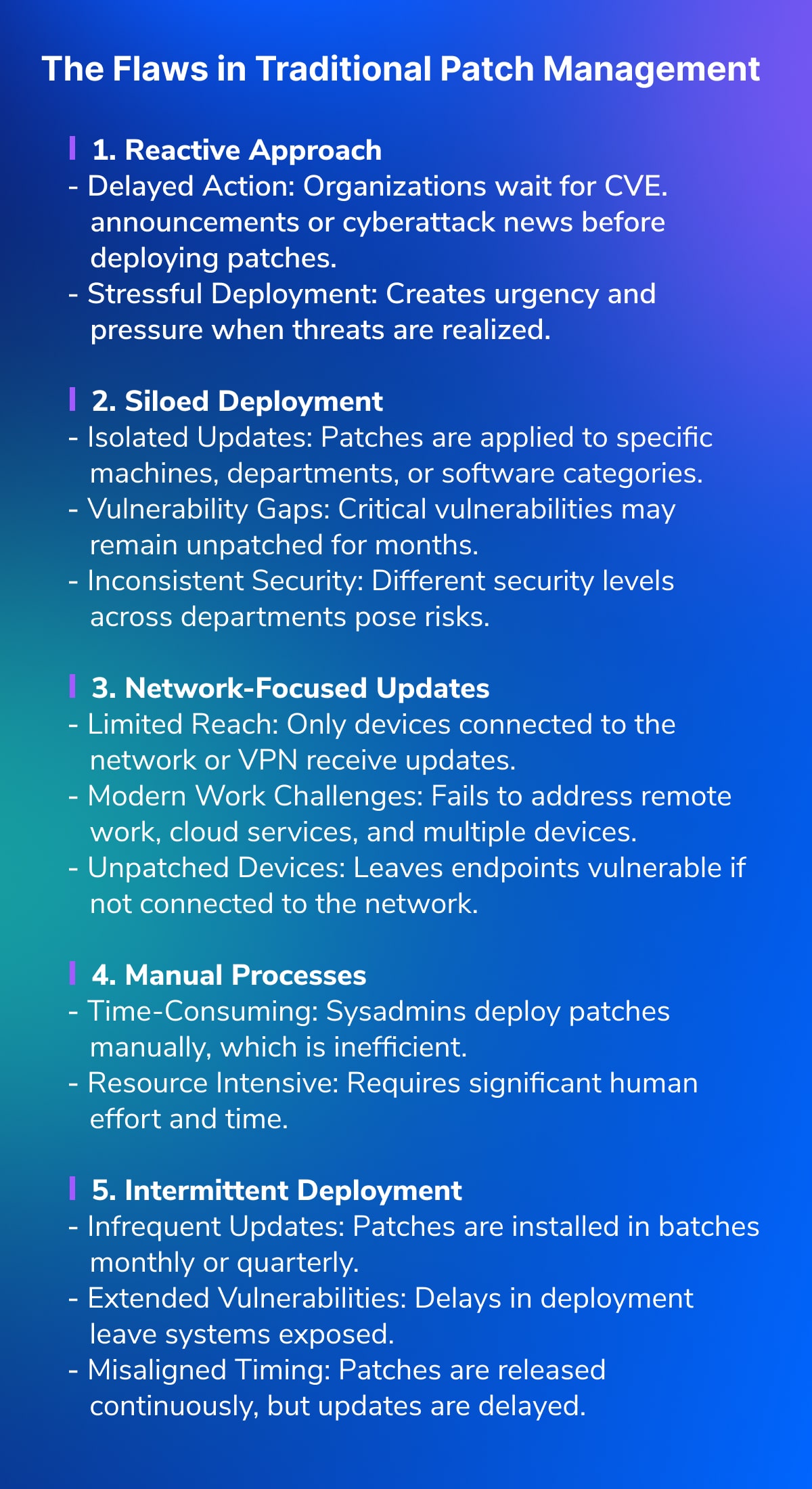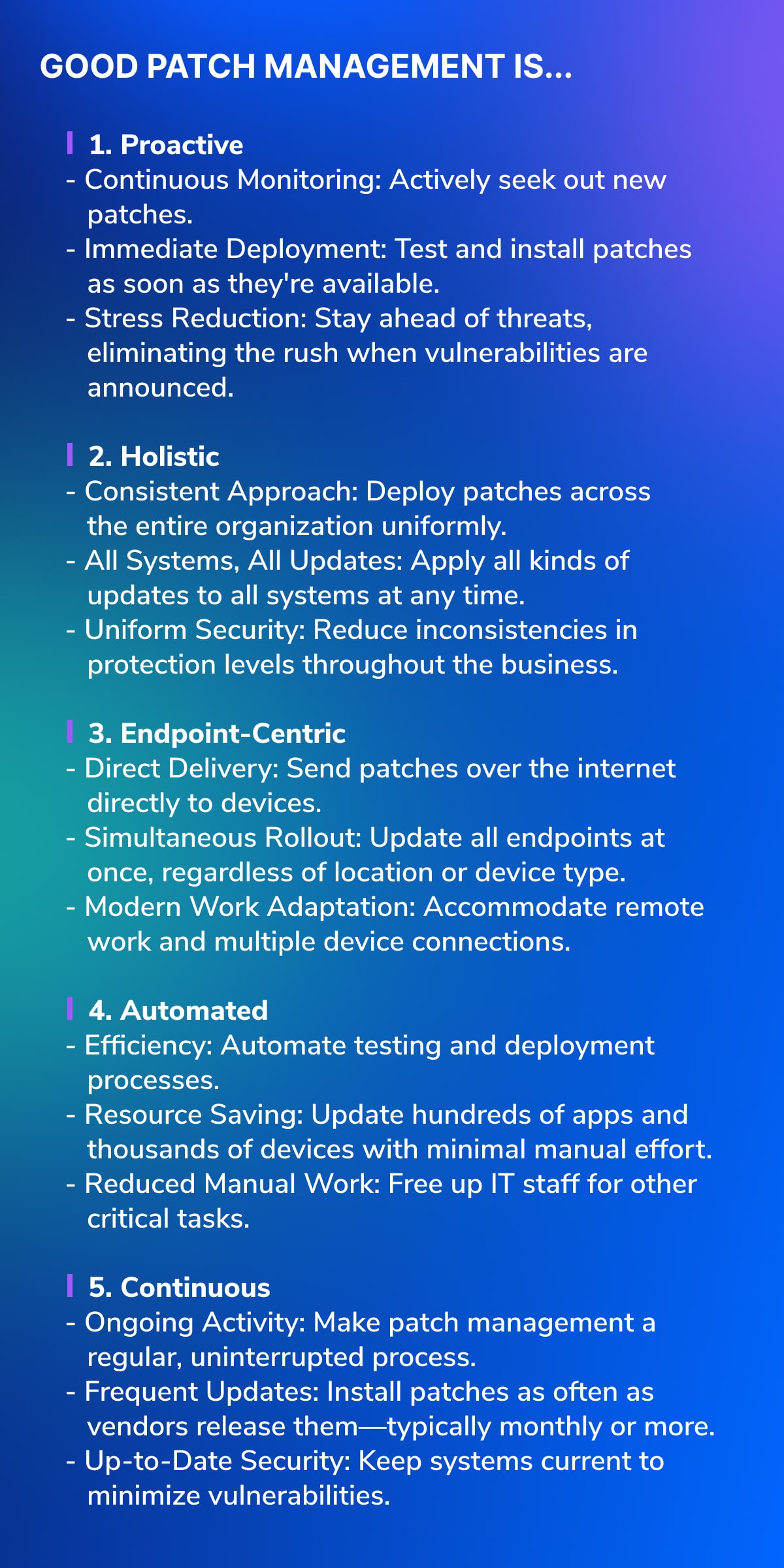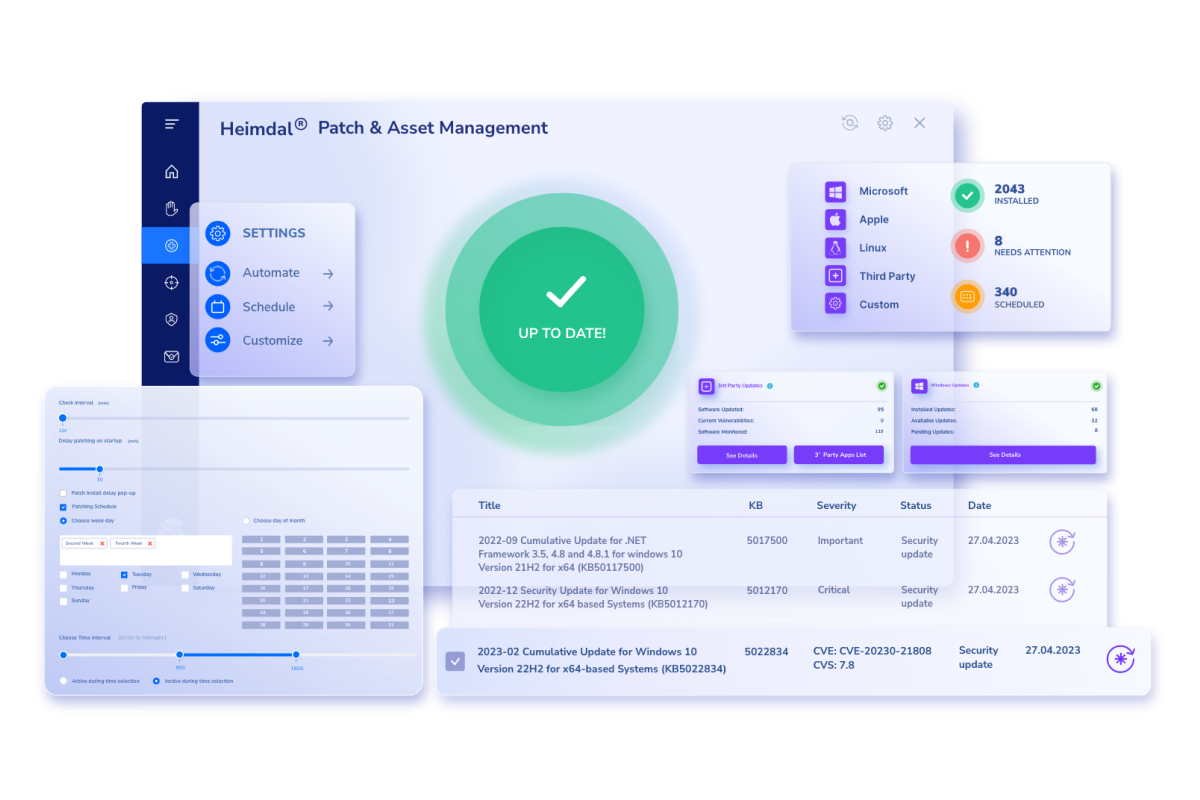Contents:
Patch management is stressful.
In one of our Heimdal webinars, we ran a snap poll with sysadmins about how they find the patch management process.
The results confirm what most of us already know: the vast majority (93%) have experienced stress around this issue.

So, why is patch management such a source of grief for IT professionals? And what can we do about it?
Key Takeaways (TL;DR)
- Traditional patch management is flawed and causes stress for IT professionals due to being reactive, siloed, manual, and intermittent.
- Adopting a proactive, holistic, automated, endpoint-centric, and continuous approach leads to effective patch management.
- Proper patch management reduces stress, requires fewer resources, aligns with modern work practices, and minimizes security vulnerabilities.
- Implementing modern patch management solutions like Heimdal’s software can transform patch deployment into a streamlined, efficient process.
The Traditional Patch Management Process Is Flawed
Patch management is a vital process that any organization needs to follow if it wishes to reduce its risk of breaches. A patch management process ensures that new updates are deployed in a timely fashion, that they’re tested before roll out, and they can protect you from danger.
However, research shows that many organizations struggle with patch management.
A 2024 survey with 220 sysadmins found a huge amount of inconsistency in how businesses plan for and roll out these updates – with many failing to follow ‘best practice’.
In our recent webinar, we discussed several common problems with patch management processes:

Standard Patch Management Is Reactive
Many organizations take a reactive approach to patch management. They tend to wait until common vulnerabilities and exposures (CVE) announcements have been published online or until they hear news about cyber attacks around the globe.
Only then do they look into patches that they should deploy.
Patch management then becomes super urgent. There’s a lot of stress and pressure to deploy patches once organizations realize that they face a threat.
Standard Patch Management Is Siloed
Sysadmins often approach patch deployment in a siloed manner. They roll out patches to specific types of machines, or for specific departments, or software categories.
Deploying patches in this way can, at first sight, make the process seem easier to manage. If you think: “today we’re going to deploy patches to our CRM software”, that can help you plan and feel like you’re doing things in a consistent manner.
But the problem is that this siloed approach means critical vulnerabilities can be left open for months – purely because they’re not at the top of the ‘to do’ list. This approach means different departments or users in the business have different levels of security – which comes with obvious hazards.
Standard Patch Management Is Network Focused
Many organizations continue to take a very traditional approach to deploying patches. Only devices or software that are connected to the network (or which connect to it via a VPN) will receive updates.
But of course, that’s not how people work today. Employees are connecting over the cloud, using multiple devices, and working remotely. Focusing on the network means organizations potentially fail to deploy patches everywhere they are needed.
Standard Patch Management Is Manual
Today, sysadmins often deploy patches manually to devices, servers or software. This is, of course, very time consuming and inefficient.
Standard Patch Management Is Intermittent
Most organizations deploy patches intermittently. They tend to install software or OS updates in batches, perhaps following a monthly or quarterly schedule. Often, patches are deployed at weekends, holidays or overnight, when there are likely to be fewer end users and disruptions.
But again, this raises problems. Patches are released by software vendors continuously, so this intermittent approach means that organizations lag behind. They may often wait weeks before deploying patches that they already had access to.
What Problems Does Standard Patch Management Cause?
If your organization’s approach to patch management is reactive, siloed, network-focused, manual and intermittent, you’re likely to experience several issues:
- Stressful: As our snap poll showed, standard patch management makes deploying updates super stressful – and many overwhelmed sysadmins experience patching paralysis.
- Time consuming: A reactive and siloed approach means that decision making and actions are delayed – and get in the way of productivity.
- Resource intensive: You need an army of people to manage patch roll outs – yet there’s a shortage of skilled IT workers as it is.
- Doesn’t match reality: The traditional approach requires all devices to be connected to the network to be updated. Yet, as we know, that’s just not how people work today.
- Leaves you vulnerable: If it takes a long time to deploy patches (or they don’t get deployed at all), then you open your organization up to potential breaches.
Interview: One sysadmin’s patch management challenges
The Art of Proper Patch Management
If traditional patch management is so problematic, then what does ‘good’ look like? In the webinar, we discussed several features of a quality, modern approach to patch management.
In many ways, good patch management is the opposite of the traditional approach:

Good Patch Management Is Proactive
Sysadmins and other IT professionals should be continually monitoring for new patches, testing and then deploying them. Rather than passively waiting for big announcements or news of breaches, you should be seeking patches out yourself and installing them ASAP.
With this approach, you’ll have identified, tested and deployed patches as soon as they become available. Then, if a CVE is announced, you have no stress – the patch has already been deployed and you don’t have to rush to install it.
Good Patch Management Is Holistic
Holistic patching is when you take a consistent approach to deploying patches across the organization. Rather than deploying patches ad hoc by department, machines or categories, you should be able to deploy all kinds of updates to all kinds of systems at any time.
By taking a holistic approach, you reduce the risk of inconsistency in protection levels or updates across the business.
Good Patch Management Is Endpoint-Centric
Modern organizations have numerous people, using multiple devices, connecting to company data in several ways. Therefore, it’s vital to shift from a network-focused approach to an endpoint-centric approach where patches are delivered to devices over the internet. You need to be able to roll out patches to all endpoints simultaneously, whatever the device, wherever it is.
Rather than waiting until a device connects to your network before you can patch it, an endpoint-centric approach means that all your tools and devices are always updated over the internet.
Good Patch Management Is Automated
With the average company using hundreds of apps and thousands of devices, updating them all manually is incredibly time-consuming and inefficient. Automated patch management means you should be able to test and roll out patches to devices at the click of a button.
Good patch management is continuous
Similarly, good patch management should be a continuous activity. Software companies release patches on a very regular basis (typically monthly, or even more frequently), and so you should be installing them just as often.
Read more: How Patch Management Software Solves the Update Problem
Be Zen: the Benefits of Proper Patch Management
Efficient, modern patch management provides multiple benefits, both to sysadmins as well as the wider business:
- Feel Zen: By having proper patch management processes in place, you avoid the stress and pressure associated with traditional methods. You can be confident that devices will be up to date and secure. You avoid urgent, stressful patch deployments when new CVEs are announced. And you can sleep sound, knowing your systems are up to date.
- Fewer resources needed: An efficient, modern patch management process requires far fewer sysadmins to run. Using automation means that many tasks are handled by patch management software, so fewer IT staff are needed to keep you protected.
- Suited to modern work: If patches are delivered over the internet, devices don’t need to be connected to the network to be updated. That matches the reality of how people work today and keeps your data safe and secure however and wherever people are working.
- Vulnerabilities are minimized: With patches being rolled out continuously, and systems always up to date, there’s far less risk that bad actors can breach your environment through known vulnerabilities.
It might sound easier said than done. So, here’s a guide on how to implement patch management software in your company.
Modern Patch Management with Heimdal®
Heimdal’s patch management software gives you the tools you need to move from traditional, inconsistent, and risky patch management to a modern, secure approach.
From a single platform, you get immediate alerts about any and all patches for the devices and software your company uses, the moment those patches become available.

Our technology then automatically screens them in a test environment. Once checked and approved by you, Heimdal rolls them out instantly to devices over the internet.
We guarantee the industry’s fastest vendor-to-end-user turnaround, with patches tested and deployed in under four hours.
All of this means that you can deploy patches more consistently, faster, and with fewer resources – and feel Zen about patch management.
Frequently Asked Questions
We answer your FAQs about patch management processes.
What does ‘good’ look like in patch management?
As we discussed in our webinar, proper patch management is automated, continuous, holistic, proactive and endpoint-centric. These characteristics mean sysadmins experience less stress, fewer resources are needed to roll out patches, all your devices are covered, and you face much lower risks from breaches.
Are organizations struggling with proper patch management?
Yes, in our snap poll of sysadmins, we discovered that 63% of IT professionals are currently facing patch management challenges. Other anecdotal evidence suggests this issue is widespread in 2024.
Is patch management effective?
It certainly can be. Modern patch management processes can significantly reduce the risk of software, hardware or OS vulnerabilities being exploited by bad actors to enter your systems. Patch management fixes bugs and closes loopholes that let hackers into your environment. But it really depends on how consistently, proactively and efficiently you roll patches out. The slower or more disordered your patch management processes, the higher the risks of being exposed.










 Network Security
Network Security
 Vulnerability Management
Vulnerability Management
 Privileged Access Management
Privileged Access Management  Endpoint Security
Endpoint Security
 Threat Hunting
Threat Hunting
 Unified Endpoint Management
Unified Endpoint Management
 Email & Collaboration Security
Email & Collaboration Security











